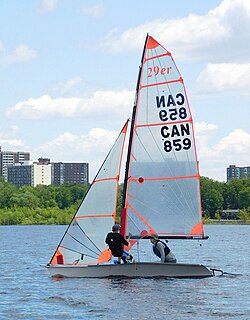| Class symbol | |
 | |
| Development | |
|---|---|
| Boat | |
| Crew | 2 (single trapeze) |
| Hull | |
| Hull weight | 74 kg (163 lb) |
| LOA | 4.40 m (14.4 ft) |
| Beam | 1.70 m (5 ft 7 in) |
| Rig | |
| Mast length | 6.25 m (20.5 ft) |
| Sails | |
| Spinnaker area | 16.83 m2 (181.2 sq ft) |
| Upwind sail area | 13.19 m2 (142.0 sq ft) |
| Racing | |
| D-PN | 84.5 [1] |
| RYA PN | 902 [2] |
The 29er is a two-person high performance sailing skiff designed by Julian Bethwaite and first produced in 1998. Derived from the Olympic class 49er class, it is raced in the ISAF Youth Sailing World Championships. [3] The 29er is able to reach high speeds fairly quickly by having a sleek and hydrodynamic hull and will often exceed the wind speed when planing both up and downwind.
